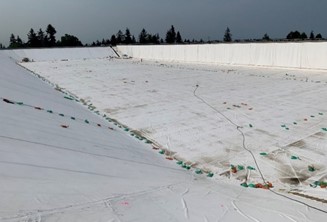
Layfield USA Corp. announced the award for the supply and installation of a new chlorosulfonated polyethylene (CSPE) liner and floating cover system for the Seattle Public Utilities Lake Forest Park Reservoir project in Washington State. The project is a unique and challenging double reservoir system with 60 million gallons (227 million L). Each reservoir cell is 200,000 square feet (18,600 m2), separated by a 25 foot (7.6 m) high vertical center wall divider. Construction started on May 28, 2021, and it is scheduled to be complete by mid-October 2021.
The floating cover system consists of a 50-mil (1.25-mm) reinforced white-colored CSPE using a defined sump design for the cover’s tension and buoyancy. The liner material is a 45-mil (1.14-mm) CSPE white geomembrane. The CSPE material replaces a polypropylene material installed in 2006 that is no longer fit for repair due to stress cracking and aging.
“Seattle Public Utilities, after a detailed review of materials, chose the CSPE material based on its proven 45-year history and 30-year weathering warranty maintaining the highest standards for the residents of Seattle,” says Brian Fraser, Layfield vice president of geosynthetics.
CSPE (formerly known by the brand name Hypalon) geomembranes were first developed in the mid-1970s. Over its 45-year product history, CSPE has proven to be an excellent material choice for long-term exposed applications for potable and wastewater storage. CSPE is recognized for its outstanding UV properties, chemical resistance and material flexibility. An industry-leading 30-year weathering warranty backs CSPE. It is one of the few materials in the geomembrane industry with a 45-year performance history.
Floating covers are designed to protect water by eliminating evaporation and preventing dirt and debris from contaminating the water source. Floating covers and reservoirs are the most economical method for storing and treating large volumes of drinking water.
 TEXTILES.ORG
TEXTILES.ORG


